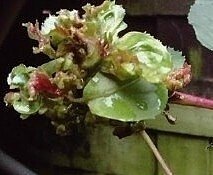
October bug of the month: Fuchsia gall mites
2 Minute Read
This month, Dr. Ian Bedford tells us everything we need to know about the 'bug of the month' for October, Fuchsia gall mites.The history of Fuchsia gall mites
Just over 300 years ago, Charles Plumier, a French monk & botanist discovered the Fuchsia in South America, and when the plants eventually arrived in Britain during 1788, they triggered a new competitive craze amongst the botanists and plant breeders of the time. Each hoping to discover more species and to then hybridise them to produce fascinating new flower forms. Consequently, Fuchsias became the country’s favourite plants of the Victorian era.
However, through to the present day, Fuchsia’s have remained popular within home gardens where their tear-drop shaped flowers are a common sight within pots, borders and hanging baskets throughout the summer. Popular also, because of their relative robustness and resilience to common plant pests and diseases.
That is until 2007 when across southern England, gardeners began finding a mysterious new problem with their Fuchsias. The flower buds were failing to open, and the new shoots were becoming strangely deformed and swollen. Nevertheless after some investigation, and careful dissection of the deformed tissue under a microscope, the cause was identified, and the mystery was solved. It was found to be the infestations of a minute arachnid mite called the Fuchsia gall mite, a foreign invasive species that was invisible to the naked eye.
That is until 2007 when across southern England, gardeners began finding a mysterious new problem with their Fuchsias. The flower buds were failing to open, and the new shoots were becoming strangely deformed and swollen. Nevertheless after some investigation, and careful dissection of the deformed tissue under a microscope, the cause was identified, and the mystery was solved. It was found to be the infestations of a minute arachnid mite called the Fuchsia gall mite, a foreign invasive species that was invisible to the naked eye.
What are fuchsia gall mites and how do they damage plants?
First discovered on Fuchsias in South America, just 30 years earlier, the mites infested, fed, and reproduced within the meristematic tissue of the fuchsia plants, and whilst doing so, produced a chemical that affected the growth of the plant’s cells, preventing them from producing normal leaves and flower buds. Consequently, through the global trade of ornamental plants, the mites spread into mainland Europe and then on to the coastal regions of southern England.
Each year, the Fuchsia gall mites are continuing to spread inland, possibly transported on the bodies of pollinators, but most likely through the propagation of infested plant material in which the symptoms of infestation have not yet become evident. Unfortunately, controlling Fuchsia gall mite is not easy, since their presence only become apparent when deformities are seen on a plant, which is after the mites have become well established in the plant’s tissue.
How to control fuchsia gall mite infestations
Unfortunately, there are no effective chemicals that can be used against them, which means that the only real option is to regularly remove and destroy the affected plant growth during the summer months. For hardy Fuchsias, cut them back as much as possible during autumn to hopefully remove mites that may remain active under bud scales throughout winter.



Middle image credit: Andy Salisbury, Head Entomologist at RHS Wisley.
Comments (0)
Why not be the first to send us your thoughts?
